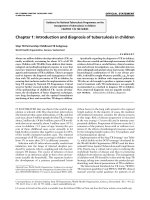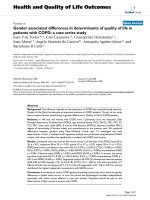Therapeutic management of Eehrlichiosis in German shepherd dog: A case reports
Bạn đang xem bản rút gọn của tài liệu. Xem và tải ngay bản đầy đủ của tài liệu tại đây (176.55 KB, 5 trang )
Int.J.Curr.Microbiol.App.Sci (2020) 9(3): 2440-2444
International Journal of Current Microbiology and Applied Sciences
ISSN: 2319-7706 Volume 9 Number 3 (2020)
Journal homepage:
Original Research Article
/>
Therapeutic management of Ehrlichiosis
in German Shepherd Dog: A Case Reports
Y. P. Maheshwarappa*, Shivanagouda S Patil, C. R. Swapna,
M. Chandrashekarappa, A. M. Kotresh and B. S. Pradeep
*Corresponding author
ABSTRACT
Keywords
edema of the
scrotum and all
limbs food intake,
dullness
Article Info
Accepted:
20 February 2020
Available Online:
10 March 2020
A 3-year-old male German Shepherd dog weighing 26 kg is presented to
Referral Veterinary Polyclinic and Teaching Veterinary Clinical Complex,
ICAR- IVRI, Izatnagar, with the history of reduced food intake, dullness,
weakness in all limbs since 1 week, edema of the scrotum and all limbs
since 3 days. Clinical examination revealed elevated rectal temperature104.30 F, tachycardia, increased respiratory rate, pale mucous membrane
along with ticks over the body was noticed. Haematological examination
showed decreased RBC count-1.93million/cmm, Leucocyte count8100/cmm, Neutrophils-75.6%, lymphocyte count-20.6%, Monocyte count3.8%, decreased HB- 4.9g%, Thrombocytopenia-80000/microlitre. Serum
biochemistry has shown normal Creatinine value-1.1mg/dl and elevated
SGPT value-218 IU/L. On blood smear examination with Giemsa staining,
Ehrlichia Morulae were noticed in Monocytes suggestive of Canine
Ehrlichiosis.
Introduction
Tick-borne diseases represent a problem of
growing importance for public health (Parola
et al., 2000). Ehrlichia canis is an obligate
intracellular rickettsial agent that is
transmitted by a brown dog tick i.e.
Rhipicephalus
sanguineus
which
is
considered as the principal vector of this
disease. ( Ristic and Holland, 1993). The
disease is characterized by a wide variety of
clinical signs of which depression, lethargy,
weight
loss,
anorexia,
pyrexia,
lymphadenomegaly,
splenomegaly,
and
bleeding tendencies are the most common.
Major hematologic abnormalities comprise of
thrombocytopenia, mild anemia, and mild
leukopenia during the acute stage, mild
thrombocytopenia in the subclinical stage,
and pancytopenia in the severe chronic stage.
The main biochemical abnormalities include
hypoalbuminemia, hyperglobulinemia, and
hypergammaglobulinemia (Harrus et al.,
1997).
2440
Int.J.Curr.Microbiol.App.Sci (2020) 9(3): 2440-2444
The
most
common
and
consistent
hematological abnormality of dogs infected
with E. Canis naturally or experimentally is
thought to be thrombocytopenia (Waner et al.,
1995). Mechanisms assumed to be involved in
the pathogenesis of thrombocytopenia in the
acute phase of the disease include increased
platelet consumption due to inflammatory
changes in blood vessel endothelium,
increased splenic sequestration of platelets,
and immunologic destruction or injury
resulting in a significantly decreased platelet
life span (Kakoma et al., 1978). E. canis
causes a potentially fatal disease in dogs that
requires rapid and accurate diagnosis to
initiate appropriate therapy leading to a
favorable prognosis (McBride et al., 2001).
Materials and Methods
A 3-year-old male German Shepherd dog
weighing 31 kg is presented to Referral
Veterinary
Polyclinic
and
Teaching
Veterinary Clinical Complex, ICAR- IVRI,
Izatnagar, with the history of reduced food
intake, fever, dullness, weakness in all limbs
since 1 week, edema of scrotum and limbs
since last 3 days. Deworming and Vaccination
history was proper.
Clinical examination revealed elevated rectal
temperature-104.30
F,
Tachycardia(155beats/min),
increased
respiratory rate, Hepatomegaly, peripheral
Lymphadenopathy, pale conjunctival and oral
mucous membrane along with ticks noticed
over the body. Blood and serum samples
were collected for hematology and serum
biochemistry, respectively.
The peripheral blood smear was prepared and
stained with Giemsa stain after methanol
fixation (Sathpathi et al., 2014). The stained
blood smear was screened for haemoprotozoa
under the light microscope. Haematological
analysis was carried out as per the standard
method (Jain, 1986). Biochemical analysis
was done with a semi-autoanalyzer. The
hemato-biochemical values were compared
with normal reference values and interpreted.
Results and Discussion
The Haematological analysis revealed
anaemia (decreased level of Haemoglobulin,
and red blood cell), Thrombocytopenia,
normal leucocyte count with neutrophilia. The
serum
biochemistry
showed
normal
Creatinine
value,
elevated
Alanine
aminotransferase
(ALT.
The
detailed
haematological and serum biochemical
parameters before therapy and after therapy
are mentioned in Table 1. The stained
peripheral blood smear was positive for
Ehrlichia morulae in monocytes (Fig. 1).
Based on history, clinical and laboratory
findings it was diagnosed as a case of Canine
Ehrlichiosis.
The treatment was started with Tab.
Doxycycline @ 5 mg/kg, PO, BID for 28
days. For the management of ticks Fiprofort
spot on was applied. Supportive treatment
was done with Inj. NS @ 200 ml very slow
IV, Inj. Meloxicam @ 0.5 mg/kg, IM, BID,
Inj. Ranitidine@ 1 mg/kg, SC, TID, Inj.
Eldervet @ 2ml, IV was given for 3 days.
Along with this, Tab.Wysolone@1mg/kg
bodyweight for 5 days followed by 0.5mg/kg
for next 5 days (Tapering dose), Hematinic
(Syp. aRBC pet @ 10 ml, PO, BID) and
Hepatoprotectant (Syp.Liv-52@ 10 ml, PO,
BID) Syrup. Thromb beat @ 10ml BID PO
was given for 4 weeks. After 4 weeks of
therapy,
the
dog
showed
marked
improvement
in
condition.
Haematobiochemical values were found within a
normal range and peripheral blood smear was
negative for E. canis on the 28th day of posttherapy.
2441
Int.J.Curr.Microbiol.App.Sci (2020) 9(3): 2440-2444
Table.1 Haemato-biochemical changes in a dog before and after therapy
Haematological Parameters
Day 0
Parameter
2.79
RBC count
3
(millions/mm )
6.3
Hemoglobin (g/dl)
3
Total WBC count (10 8.6
cells/mm3)
87
Neutrophils (%)
7.2
Lymphocyte (%)
3.8
Monocytes (%)
2
Eosinophils (%)
0
Basophils (%)
3
0.8
Platelets (lakhs/mm )
Serum Biochemical Parameters
Day 0
Parameter
Day 28
6.27
Reference
range*
5.0-7.9
13.2
11.3
12-19
5.0-14.1
72
22.5
3.5
2
0
1.86
58-85
8-21
2-10
0-9
0-1
2.11-6.21
Day 28
Reference
range#
Key findings
Anaemia
ALT (U/L)
218.8
127.9
10-109
Creatinine (mg/dl)
1.12
0.871
0.5-1.7
Neutrophilia
Thrombocytopenia
Elevated-liver
specific enzyme
* March 2012: Haematology reference ranges, 10th edn. The Merck Veterinary Manual
# March 2012: Serum biochemical reference ranges, 10th edn. The Merck Veterinary Manual
Fig.1 Ehrlichia canis morula (arrow) in monocyte (Giemsa stain)
2442
Int.J.Curr.Microbiol.App.Sci (2020) 9(3): 2440-2444
The exact pathogenesis of CME remains
unknown. It has been suggested as a
mechanism for pathologic alterations and
clinical signs are due to Immunologic
dysfunction.
Increased
production
of
interleukin-1 (IL-1) by antigen-presenting
cells and B cells or exogenous pyrogen
products of the parasite are responsible for
Fever and some clinical signs and symptoms
observed in all infected dogs (Gershwin et al.,
1995).
These alterations were already manifest
between days 10 and 14 after infection,
similar to the findings reported in naturally
infected and dogs experimentally exposed to
E. canis by (Huxsoll et al., 1972) and (Pierce
et al., 1977), respectively. The clinical
findings such as pale mucous membranes,
hepatomegaly,
lymphadenopathy,
splenomegaly, emaciation, increased hair loss
and hematological alterations observed in
these infected animals have been previously
reported in cases of canine ehrlichiosis
(Hoskins, 1991; Troy and Forrester, 1990).
Thrombocytopenia, leucopenia, and anemia
are most frequently observed in CME
(Hoskins, 1991; Davoust et al., 1991).
Infected dogs presented mild to moderate
hematological changes in acute experimental
infection for just a few weeks. The tendency
for the hematological parameters to return to
normal was evident at the end of the
experiment. This result may be a consequence
of transient suppression of bone marrow
activity due to E. canis infection (Buhles et
al., 1975).
It has been assumed that the pathogenesis of
thrombocytopenia is due to Anti-platelet
antibodies produced in CME (Harrus et al.,
1996). Anemia may explain the observed
paleness of mucous membranes and most
organs. Lymphadenopathy, splenomegaly,
ascites, paleness of mucous membrane,
kidney and liver, and discrete pulmonary
congestion were observed at the necropsy of
inoculated dogs as has been previously
reported in cases of canine ehrlichiosis
(Hildebrandt et al., 1970; Hildebrandt et al.,
1973 ). observed the same in German
Shepherd
dogs
and
posited
breed
susceptibility (Nyindo et al., 1980).
References
Buhles, W. C., Huxsoll, D. L. and
Hildebrandt, P. K. 1975. Tropical
Canine Pancitopenia: role of aplastic
anemia in the pathogenesis of severe
disease. J. Comp. Pathol. 85, 511-521.
Davoust, B., Parzy, D., Vidor, E., Hasselot,
N. and Martet, G. 1991. Ehrlichiose
Canine Experimentale: etude Clinique
et therapeutique. Rec. Med. Vet. 167,
33-40.
Gershwin, L. J., Krakowka, S. and Olsen, R.
G. 1995. Cytokines. In: Immunology
and Immunopathology of Domestic
Animals, 2nd ed. Mosby. St. Louis. 4046.
Harrus, S., Waner, T. and Bark. H. 1997.
Canine monocytic ehrlichiosis - an
update. Comp. Cont. Ed. Prac. Vet. 19,
431- 444.
Harrus, S., Waner, T., Weiss, D. J., Keysary,
A. and Bark, H. 1996. Kinetics of serum
antiplatelet antibodies in experimental
acute canine ehrlichiosis. Vet. Immunol.
Immunopathol. 51, 13-20.
Hildebrandt, P. K., Huxsoll, D. L. and Nims,
R. M. 1970. Experimental ehrlichiosis
in young Beagle dogs. Fed. Proc. 29,
754.
Hildebrandt, P. K., Huxsoll, D. L., Walker, J.
S., Nims, R. M., Taylor, R. and
Andrews, M. 1973. Pathology of canine
ehrlichiosis
(Tropical
canine
pancytopenia). Am. J. Vet. Res. 34,
1309-1320.
Hoskins, J. D. 1991. Ehrlichial diseases of
dogs: diagnosis and treatment. Canine
2443
Int.J.Curr.Microbiol.App.Sci (2020) 9(3): 2440-2444
Pract. 16, 13-21.
Huxsoll, D. L., Amyx, H. L., Helmet, I. E.,
Hildebrandt, P. K., Nims, R. M. and
Gochenour. W. S. 1972. Laboratory
studies
of
Tropical
Canine
Pancytopenia. Exp. Parasitol. 31, 53-59.
Jain. N. C. 1986. Schalm’s Veterinary
Hematology. Fourth ed., Lea and
Febiger, Philadelphia.
Kakoma, I., Carson, C. A., Ristic, M.,
Stephenson, E. M., Hildebrandt, P. K.
and Huxsoll, D. L. 1978. Platelet
migration inhibition as an indicator of
immunologically mediated target cell
injury in canine ehrlichiosis. Infect.
Immun. 20, 242-247.
McBride, J., Corstvet, R., Breitschwerdt, E.
and Walker, D. 2001. Immunodiagnosis
of Ehrlichia canis Infection with
Recombinant
Proteins.
J.
Clin.
Microbiol. 39, 315-322.
Nyindo, M., Huxsoll, D. L., Ristic, M.,
Kakoma, I., Brown, J. L., Carson, C.A.
and Stephenson, E. H. 1980. Cellmediated and humoral immune response
of German shepherd dogs and beagles
to experimental infection with Erlichia
canis. Am. J. Vet. Res. 41, 250-254.
Parola, P., Roux, V., Camicas, J-L., Baradji,
I., Brouqui, P. and Raoult, D. 2000.
Detection of ehrliciae in African ticks
by polymerase chain reaction. Trans. R.
Soc. Trop. Med. Hyg. 6, 707-708.
Pierce, K. R., Marrs, G. E. and Hightower, D.
1977. Acute canine ehrlichiosis: platelet
survival and factor 3 assay. Am. J. Vet.
Res. 38, 1821-1825.
Ristic, M. and C. J. Holland. 1993. Canine
ehrlichiosis In Z. Woldehiwet and M.
Ristic (ed.), Rickettsial and chlamydial
diseases of domestic animals. Pergamon
Press, Oxford, United Kingdom. 169186.
Sathpathi. S., Mohanty, A. K., Satpathi, P.,
Mishra, S. K., Behera, P. K., Patel G.
2014. Comparing Leishman and Giemsa
staining for the assessment of peripheral
blood smear preparations in a malariaendemic region in India. Malaria.
journal. 13 (1): 512.
Troy, G. C. and Forrester, S. D., 1990.
Canine Ehrlichiosis. In: Greene, C.E.,
Infectious Diseases of the Dog and Cat.
W.B. Saunders, Philadelphia, 48-59.
Waner, T., Harrus, S., Weiss, D. J., Bark, H.
and Keysary, A. 1995. Demonstration
of serum antiplatelet antibodies in
experimental acute canine ehrlichiosis.
Vet. Immunol. Immunopathol. 48, 177182.
How to cite this article:
Maheshwarappa. Y. P., Shivanagouda S Patil, C. R. Swapna, M. Chandrashekarappa, A. M.
Kotresh and Pradeep. B. S. 2020. Therapeutic management of Ehrlichiosis in German
Shepherd Dog: A Case Reports. Int.J.Curr.Microbiol.App.Sci. 9(03): 2440-2444.
doi: />
2444









